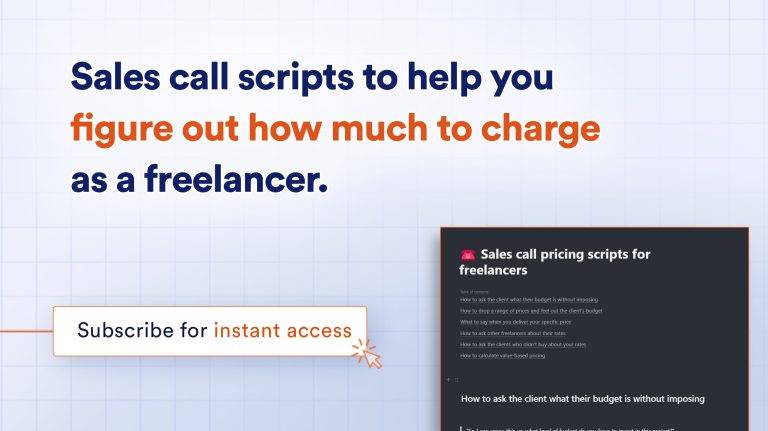One of the most difficult dilemmas I face in freelancing is knowing how much to charge for my services.
If the client say yes immediately I think
“Damn. Shoulda charged more”
If they ghost me, I always wonder
“Damn. Was I too expensive?”

So how do we work out pricing when everyone holds their cards close to the chest?
Over the years I’ve built up a collection of strategies I use all the time,
to successfully figure out my rates as a freelancer and price with confidence
Lets’ dive in:
Bring up money early
But not too early.
Never just send over your packages.
and don’t lead with price.
Why?
leading with price starts a conversation about prices.
This makes price the most important decision factor.
But it’s not.
Price is what you pay for something.
Value is how much it pays off.
If they ask for price, you have to scope it up before you can quote.
I’d be worried hiring someone that just blurts a number without figuring out my needs first.
This week I was contacted by a customer who have spent £2000 on a website which isn’t fit for purpose.
If I charge them £4000 for a website which delivers steady leads, which is the better value?
Sometimes you have to take time to demonstrate this difference to the client, before you talk about price.
Talking about price immediately sends the message that all you care about is money.
I treat my sales calls as an opportunity to give advice freely and demonstrate my value.
You can give rough ballparks early to vet your leads, and weed out timewasters
I don’t want to waste a 30 min call, educating a customer on the value of good branding,
if they just want a “basic logo” for their candle making sidehustle, and they only have 50p to spend.
It’s a waste of my time, and a waste of their time.
At least make sure your in the right ballpark to avoid wasting each others time.
If you’re getting vibes that they aren’t a good fit, or they can’t afford it,
bring up your minimum rate early.
minimum level of investment early to weed out tyre kickers,
but withhold specific prices till the end when they understand the value.
So how do we do this?
Minimum rate
You can quickly quote your “minimum level of investment”
Unless you work for a company, as a freelancer you have other roles beyond just “designer”.
You still need to
- find your customers
- promote your work
- do admin
- communicate with clients
- submit your tax returns
- etc.
The fees you charge has to cover all this stuff.
Your “minimum rate” is the absolute minimum that you’re willing to accept to get involved with a project.
Start by writing down your desired annual salary. be realistic.
Divide your desired annual salary by 52 weeks.
That gives you the amount you need to earn per week.
Then, take that amount and divide it by 40. That gives you a rough hourly rate you need to charge clients
But remember, you still have all your overheads to cover…
Flexible rates
Here’s something folks don’t tell you.
Your prices can change.
Sometimes I quote different rates depending on
How much I want the job
How busy I am
But here’s the kicker.
I don’t usually charge rates at all.
I never quote an hourly rate if I can help it,
and I recommend you stop doing hourly rates as soon as possible.
It’s a really bad way to price.
Here’s why.
Why to never price hourly rates as a freelancer
Hourly pricing punishes you for being good at your job.
As you get better and more experienced you’re going to do things more quickly than someone with less experience.
If Lewis Hamilton gets faster lap times, would you pay him less or more? 🏎️
👆🏻 THAT’s the problem with hourly based pricing…
In a lifestyle business, as a solo business, you only have a certain number of hours in a day.
And if you are working on an hourly based pricing, there’s a very low ceiling to how much money you can make in the number of hours of the day you have.
You can only put your hourly rate up so much.
Or work more hours is the other option, which no one wants to do.
Switch to Value based pricing
I would encourage you to move to what’s called value based pricing.
This means your price is based on the value that you deliver, instead of the hours you work on it,
which means that your price is different depending on every client.
Money is just an exchange of value. We all agree on how much £1 is worth.
But your services don’t work like that.
Here’s an example:
- You build a landing page and ecommerce site for a solopreneur with a sidehustle in selling homemade candles to freinds and family. You might help her generate £1000/m in sales.
- You build a landing page and ecommerce site for a business selling bespoke garden office pods. It generates £100,000/m in sales.
Obviously, the value of this work is very different, even though the deliverables are the same.
This is why I don’t charge per hour, I charge based on the value I can generate for the client.
It’s sometimes more of a feeling than a science,
but generally you should be charging 10-30% of the value you deliver.
Of course, this depends on you being able to deliver value.
Logo designers => start creating brands
web designers => start building websites that generate leads
This is the only win-win relationship which is fair.
Now, as you level up your skills, and solve more difficult problems for your client, your value will also increase, and your competition decrease.
How to calculate the value you can deliver
The value is most often determined by how much money the the client can make from my help…
I’ve created some easy questions you can ask to find out what the budget is.
After asking these questions you can do some napkin sketch math to break down the figures for them.
If I can produce a landing page that gets them x10 more leads per month at £100 per customer
then that landing page is worth £12k over a year, every year forever.
If we take third of just your first year, and spread over a few instalments, you’re looking at £3.6k for a website.
Now this sounds a lot more attractive than just saying £3.5k for a landing page.
Your price should reflect your value
Everyone will do a mental calculation of your worth in their head when they meet you.
The calculation is a balance of
- the result your provide
- What people are willing to pay for that result.
- How easy the believe it will be to achieve the result
- How confident they are you can deliver the result
The reason so many freelancers undercharge?
because freelancers don’t value their work.
I don’t want to be fluffy, but self-confidence is key here.
If you struggle with self-confidence this might help
Once you get good at your core skill you can continually up your fees.
The more experience you have,
the more confidence you have in your results,
the less risk for the client,
the higher the rate they will pay.
People pay more for a sure thing.
But your rates aren’t just determined by your mad photoshop Sk1llz.
Stop selling your services, start selling your process
The client isn’t just paying for results,
they are paying for the experience too.
You can increase your prices for intangibles.
Here are some things you can charge more for:
- Reliability
- Clear communication
- A stress-free process
- Clarity
- Lack of stress
- Speed
- Extra handholding
- Niche knowledge
- Industry contacts
I know I’ll never be the best designer.
So I focus on providing the best project experience instead.
Start by quoting a price ranges instead of fixed fees
The value I can generate for the client can sometimes be tricky to quantify. 🤣
Most often, I have to make a best guess.
IF the client doesn’t want to give you their budget,you can give them a range instead.
Offering x3 packages can help you narrow it down.
If you have a well defined offer:
20-30% of the value of promise
If you don’t have a well defined offer or package
You can grab my offer worksheet to work out your offer,
and build your services and pricing around that.
The more you repeat your package of services, the more data you get on how people react to it, and the easier it becomes to price,
But what about new services?
Get paid to learn
People hate on me when I say this,
but despite what social media tells you,
if you don’t have the experience, you shouldn’t be charging higher rates.
Eventually you will want to pick up or offer new skills to expand the value you deliver.
When you do this you’ll be new to that skill.
I take the mindset that if I’m learning, I lower my rates,
and treat it as getting “paid to learn”
Sometimes I’m happy to break even and learn.
My policy is if you have less experience, treat it as being paid to learn and go cheaper.
Don’t try to charge high ticket prices if you aren’t confident of the results.
Long term relationships are more important than a quick buck.
This is how I learned SEO.
at rock bottom prices.
Years later I charge £150/hr minimum because I’ve gained experience.
Earlier, the client gets a lower rate,
I get paid to learn a valuable skill I can later charge more people for.
It’s a win-win.
Adjust for risk
If there are time constraints, unknowns, unclear scope, if you spot client red flags, increase your minimum level of investment.
If you think it’s unfair to treat clients differently, first consider the Pareto Principle:
“Roughly 80% of effects come from roughly 20% of causes.“
In other words:
A small portion of our clients will cause most of our stress and problems.
-
- 80% of your leads will come from 20% of your marketing efforts.
- 80% of your income will come from 20% of your jobs.
- 20% of your clients will consume 80% of your time.
You should be compensated more for investing more time in the client.
By adapting your behaviour you can set your boundaries before problems appear, adjust your systems, and provide extra care where it’s needed to provide a better experience and result for yourself and the client.
So sorry clients, but “asshole tax” does exist, and it is valid for pricing projects.
I personally hate the phrase “asshole tax”, I prefer the softer term “extra handholding”.
Some of your nicest, friendliest, favourite clients may need to be charged “asshole tax”.
Not that you have favourites, I know you love all your lovely clients equally of course!
Not because they are assholes, but because they just need a bit of extra help, guidance and management.
It’s simple math:
Some people may be technophobes and need you to walk them through things that others would take for granted like signing into their email accounts etc.
Others may have the gift of the gab, and like to chitchat for an extra half hour on every feedback call.
This is fine, but time is money.
Extra time = extra costs therefore charge enough asshole tax to cover the extra time.
Never tell them you’re charging them asshole tax. Obviously.
You should allow extra time to help them out, and increase your minimum rate, to allow for unforseen complications.
Include overheads
As a rule of thumb do a rough calculation of how long you think each stage of the project will take.
Then add 20% for safety and another 15% for admin and communication.
Don’t know how long your projects take?
Start tracking your time.
Not just doing the job, but answering emails related to the job, processing invoices, everything.
Over time you’ll get more accurate with your estimate.
Add a margin of safety to your quotes
Your estimates will be accurate to the point where when someone approaches you with a problem,
you know how to solve it and you know how long it’ll take to solve it,
and you can quote with confidence and close on the call,
without going away to research or scope up.
The more uncertain you are,
the bigger your quote range should be.
Ask other freelancers
The more open we are about our rates, the better.
Stop thinking of your fellow freelancers as rivals,
start thinking of them as partners,
or fellow travellers, in the very least.
Ask a few colleagues or friends.
You should go first, and ask them to share their own in return
There’s a script I use to ask other freelancers their rates without imposing
Ask the clients who didn’t buy
Some freelancers as for feedback on finished projects.
Very few ask failed enquiries.
This is where the gold lies.
Most times you won’t get an answer
But sometimes you get blunt feedback that opens your eyes and improves your game for all future enquiries.
These people are gold.
They tell you what everyone else is thinking.
- Don’t take it personally,
- Don’t get defensive
- Don’t explain yourself.
- Don’t respond directly to the feedback, except to thank them.
There’s a script I use to ask failed leads why they didn’t buy
Also…
A closed lead is never really closed.
10 – 15% of the time, I turn closed leads into new clients, sometimes months or even years later.
If you want to do this too, here’s an lead generation system for freelancers that you can set up to recycle your closed leads into new leads.
Just ask
The first strategy is just ask.
Don’t be shy, it gets easier the more you do it.
I just come out with it.
They probably won’t tell you, or will ask you to go first.
You can then lead them into a discussion about scope.
That’s the worst case scenario.
The specific phrasing is key to getting them to open up.
I’ve included the exact script I use to ask about budget without imposing for my subscribers.
You’ll often be blown away at what they thought they were going to pay.
adjust your prices on the fly accordingly.
This isn’t about price gouging;
If you offer multiple services, and if you know their budget,
you can figure out how you can deliver the best “bang for their buck”
Most often they won’t tell you.
That’s fine.
If they won’t give you their budget give them a range of figures and gauge the reaction.
Here’s a script to quote a range of prices and feel out where they sit on the scale.
Drop a few pricing markers
You may want to mention a few previous projects you’ve done that have a similar scope,
or similar result, to anchor expectations of the budget in advance.
You can usually find a ballpark indication of budget is by asking these questions:
- What do you sell and who to?
- Where do your leads come from?
- how much is 1 customer worth over a year?
- how many leads do you get a month?
- how many leads do you convert?
Feeling out client budget
Even then, final budget can vary quite a lot depending on the level of service.
if you shop for a car, you can get Skodas, or you can get a Ferrari.
If you want the Ferrari, do you also want the custom door trims and heated steering wheel with that?
If they don’t tell you their needs, how can you quote for it?
So if you’ve asked, and they don’t tell,
then you can then start to feel out the appropriate budget,
by quoting a price range instead of a fixed price.
This keeps your options open, and continues the discussion without committing to anything.
Here’s the script I use to quote a price range
Keep your range wide,
and gauge their reaction to see how much they are expecting to pay,
Most will come in the middle of this range,
so if you need a higher budget to achieve their goal,
then adjust the upper range of your price range upwards accordingly,
and adjust the low end of your range to your minimum level of investment.
But always be reasonable and realistic with your range.
You should only include real figures of real budgets.
Quoting too high can have unexpected consequences…
Charging for everything vs free extras?
As your price increases, expectations also increase.
I learned this lesson the hard way:
As you hone your offer towards providing results,
as you move away from hourly pricing, towards value pricing,
you must change the way you look at pricing and money.
You aren’t selling your time anymore.
You’re selling a result.
This isn’t Ryan-Air,
The client is going to be surprised and annoyed if you start trying to charge them for every little thing.
If you want to charge more than your competition,
you have to get used to giving away the kind of value for free that others are charging pocket change for…
My basic rule of thumb is:
Will the client make money from it, or save time from it?
Then charge for it.
If you’re charging high ticket prices for an all-inclusive service,
the client is going to expect more 1-1 time and guidance.
If it’s something that takes you only a little extra time, but adds value for your clients, consider throwing it in.
But as a bonus!
Make sure they know what it would normally cost.
I see a lot of freelancers going the extra mile, And no-one even knows how big a deal it is.
It’s likely this “little thing” that takes you ten minutes, actually took you years to learn.
Reasonable clients will ask for reasonable things, and will understand when the thing they ask for is beyond the freebie zone.
As for unreasonable clients….
Asshole tax / F* you prices
Sometimes I take on x2 projects with the exact same scope:
One of them I can breeze through in a week,
the other drags on for months and time tracking is through the roof.
What’s the difference?
the client.
No-one likes talking about this.
but “asshole tax does exist, and it is a valid strategy for pricing projects.
I don’t like the phrase “asshole tax”. I prefer “hand holding”.
I know you don’t play favourites.
I know you love all your lovely clients equally of course!
But even some of your nicest, friendliest clients may need extra work.
Not because they are assholes;
but because they just need a bit of extra help, guidance and management.
Some people may be technophobes and need you to walk them through things that others would take for granted like signing into their email accounts etc.
Others may have the gift of the gab, and like to chitchat for an extra half hour on every feedback call.
This is fine, but time is money.
Extra time = extra costs therefore charge enough asshole tax to cover the extra time.
Never tell them you’re charging them asshole tax. Obviously.
Just help them out.
It’s simple ass math.
If you are on the fence about a project,
you don’t really want to do the job,
the client is disorganized
or you’re getting some major red flag vibes….
Then quote a wild price on the off chance they take you up on it
Sometimes I’m willing to put up with high maintenance clients, push through some boring projects, or do some extra hand holding tolerate if the money is good enough.
How to close a sale on your final price
It’s not your job to meet the client’s budget, or force them into a sale.
It’s your job to tell them what it costs to achieve the result they want,
and present them with the options.
The rest is up to them.
Listen to them during the call, ask questions.
Then present your service as a product which fills all the needs they told you about at a price that they will accept and still feel is valuable for the result that they will get.
I’ve written a complete script of how to pitch your final price with success.
When you tell them your price then go silent and wait for them to accept,
or they will hesitate and start talking about objections.
Ask them openly “what are your concerns at this point?”
answer those concerns, you might need to draw the concerns out of the client at this point.
once answered any concerns you can basically repeat your closing line.
If you’ve done your sales call right, this most often closes the sale.
Discounts and price adjustments.
Should I do discounts?
I never do discounts.
If you run a service business,
you can remove deliverables or adjust scope.
If you do a discount once,
it’ll be expected every time,
and resented when you don’t.
Also, it looks desperate.
Bad actors may use this to leverage and manipulate you.
Clients who expect arbitrary discounts, are often bad actors.
What if you quote too high?
It’s always easier to quote high and remove deliverables than it is to quote too low.
If your worried about not getting the job think of it this way :
Doing the job too cheap is worse than not doing the job at all.
If you get the job too cheap,
you have to complete the work AND you’re not getting paid for it.
If you quote too high and don’t get the job, you don’t get any money, but you don’t have to do the work either.
What if you quote too low?
If you quote too low it’s too late.
I always stick to my guns, even if it hurts me.
Never revise your price upwards after you’ve quoted, the trust will be lost forever,
and you’ll have to go find another client.
It’s 10x cheaper to do one job slightly low and hang onto existing clients.

Want scripts you can use on sales calls to figure out your pricing as a freelancer, without putting off clients?
Subscribe for instant access to my freelance pricing guide scripts.
















